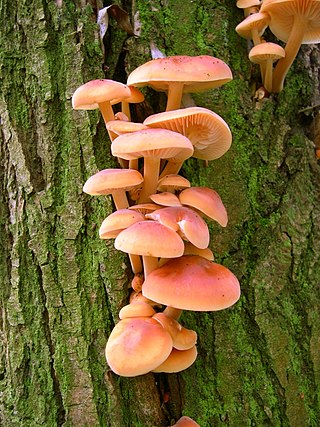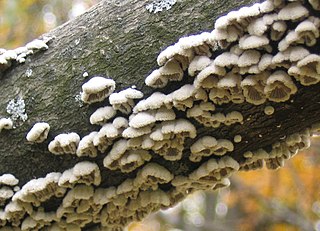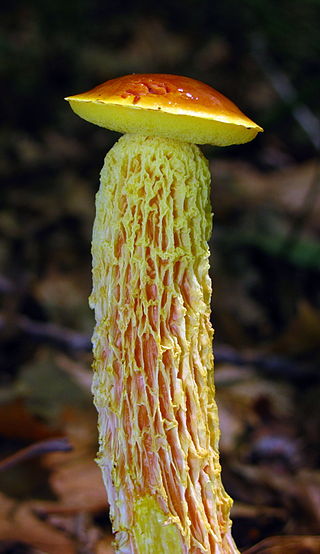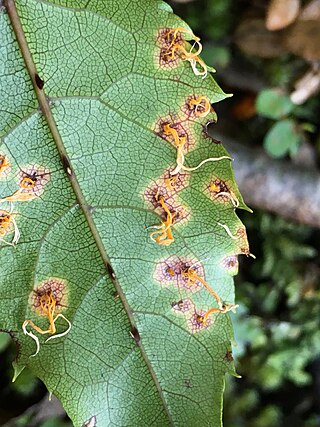Related Research Articles

The Russulales are an order of the Agaricomycetes,. According to the Dictionary of the Fungi, the order consists of 12 families, 80 genera, and 1767 species. According to Species Fungorum, the order contains 13 families, 117 genera, and 3,060 species.

Flammulina is a genus of fungi in the family Physalacriaceae. The genus, widespread in temperate regions, has been estimated to contain 10 species.

Alternaria is a genus of Deuteromycetes fungi. All species are known as major plant pathogens. They are also common allergens in humans, growing indoors and causing hay fever or hypersensitivity reactions that sometimes lead to asthma. They are present in the human mycobiome and readily cause opportunistic infections in immunocompromised people such as AIDS patients.

The Schizophyllaceae are a family of fungi in the order Agaricales. The family contains two genera and seven species. Species cause white rot in hardwoods. The most common member of the genus Schizophyllum is Schizophyllum commune, a widely distributed mushroom.

Ceratobasidium cornigerum is a species of fungus in the order Cantharellales. Basidiocarps are thin, spread on the substrate out like a film (effused) and web-like. An anamorphic state is frequently obtained when isolates are cultured. Ceratobasidium cornigerum is saprotrophic, but is also a facultative plant pathogen, causing a number of economically important crop diseases, and an orchid endomycorrhizal associate. The species is genetically diverse and is sometimes treated as a complex of closely related taxa. DNA research shows the species actually belongs within the genus Rhizoctonia.
Fusarium crookwellense is a species of fungus in the family Nectriaceae. It is known as a plant pathogen that infects agricultural crops.

The Corticiales are an order of fungi in the class Agaricomycetes. The order is composed of corticioid fungi. Species within the order are generally saprotrophic, most of them wood-rotters, but several are parasitic on grasses or lichens. Plant pathogens of economic importance include Erythricium salmonicolor, Laetisaria fuciformis, Waitea circinata, Waitea oryzae, and Waitea zeae.

Heimioporus is a genus of fungi in the family Boletaceae. The genus is widely distributed in tropical and subtropical regions, and contains about 15 species.
Schenella is a genus of fungi in the family Geastraceae. The widely distributed genus contains four species. The genus was circumscribed by Thomas Huston Macbride in 1911. Pyrenogaster, described in 1977, is a later synonym.
Palaeocephala is a genus of fungi. This is a monotypic genus, containing the single species Palaeocephala cymatelloides, described by Rolf Singer in 1962. According to the Dictionary of the Fungi, the genus is classified in either the Marasmiaceae or Physalacriaceae families; the taxonomical database MycoBank includes it in the Marasmiaceae.

Chlamydosauromyces punctatus is the sole species in the monotypic genus of fungi, Chlamydosauromyces in the family, Onygenaceae. It was found in the skin shed from frilled lizard. This fungus is mesophilic and digests hair. It reproduces both sexually and asexually. The fungus has so far not been reported to be pathogenic.
Polytolypa is a monotypic genus of fungus containing the single species Polytolypa hystricis. First classified in the Onygenaceae family, as of 2008 it is considered to be in the Ajellomycetaceae, although there is still uncertainty as to its phylogenetic relationships with other similar genera. This species is only known from a single specimen derived in the laboratory from a specimen of dung of the North American porcupine, Erethizon dorsatum, collected in Ontario, Canada. Polytolypa hystricis contains bioactive compounds that have antifungal activity.

Ramularia is a genus of ascomycete fungi. Its species, which are anamorphs of the genus Mycosphaerella, are plant pathogens. Economically important host species include Narcissus, sugar beet, and barley.
Sphaceloma is a genus of ascomycete fungi. Its species are plant pathogens, and cause anthracnose and scab diseases. The widespread genus is estimated to contain 52 species.

The Gallaceaceae are a family of fungi in the order Hysterangiales, containing species found in Australia and New Zealand. The family contains three genera and 16 species.
Circulocolumella is a genus of fungus in the Hysterangiaceae family. The genus is monotypic, containing the single species Circulocolumella hahashimensis, found in the Bonin Islands of Japan, and is now extinct.

Hamaspora is a genus of rust fungi in the family Phragmidiaceae. The genus contains 14 species, which are known from Africa, Asia, and Australia.
Trachyspora is a genus of rust fungi in the family Phragmidiaceae. The genus, widespread in northern temperate areas, contains six species.
Nothocastoreum is a fungal genus in the Mesophelliaceae family. The genus is monotypic, containing the single truffle-like species Nothocastoreum cretaceum, found in Australia.
Curvularia inaequalis is a plant saprobe that resides in temperate and subtropical environments. It is commonly found in the soils of forage grasses and grains. The species has been observed in a broad distribution of countries including Turkey, France, Canada, The United States, Japan and India. This species is dematiaceous and a hyphomycete.
References
- 1 2 "Quambalaria J.A. Simpson 2000". MycoBank . International Mycological Association. Retrieved 11 April 2024.
- ↑ Murray P, Baron EJ, Jorgensen JH, Pfaller MA, Yolken RH (2003). Manual of Clinical Microbiology (8 ed.). American Society for Microbiology. p. 1753. ISBN 978-1-55581-255-3.
- ↑ Beer ZW de; Begerow D; Bauer R; Pegg GS; Crous PW; Wingfield MJ. (2006). "Phylogeny of the Quambalariaceae fam. nov., including important Eucalyptus pathogens in South Africa and Australia". Studies in Mycology. 55: 289–98. doi:10.3114/sim.55.1.289. PMC 2104727 . PMID 18490987.
- ↑ Quambalaria in MycoBank .
- ↑ Simpson JA. (2000). "Quambalaria, a new genus of eucalypt pathogens" (PDF). Australasian Mycologist. 19 (2): 57–62.